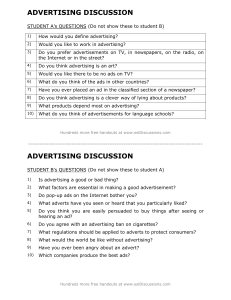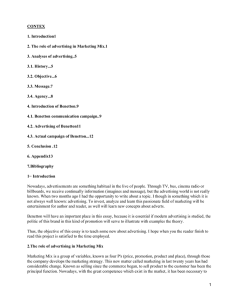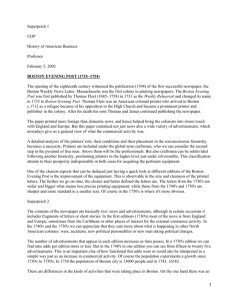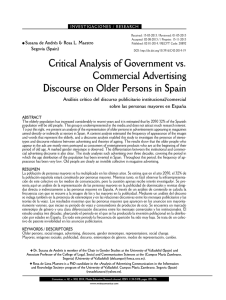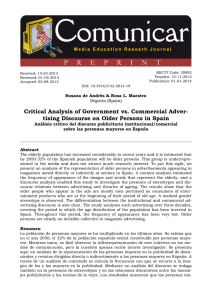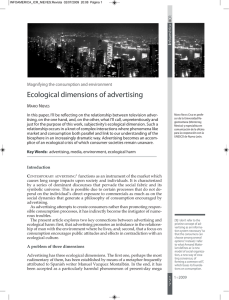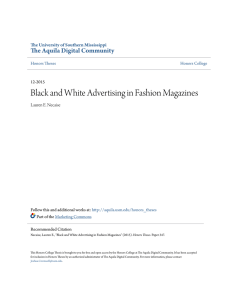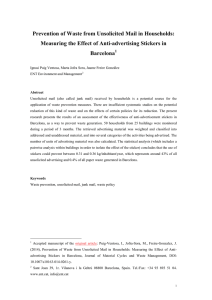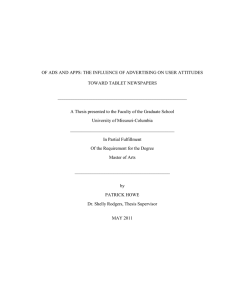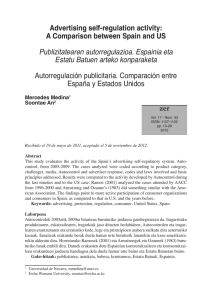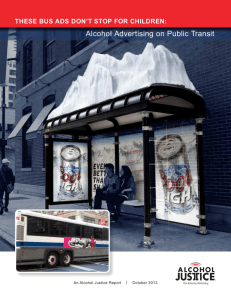Creating an adversiting campaign
Anuncio
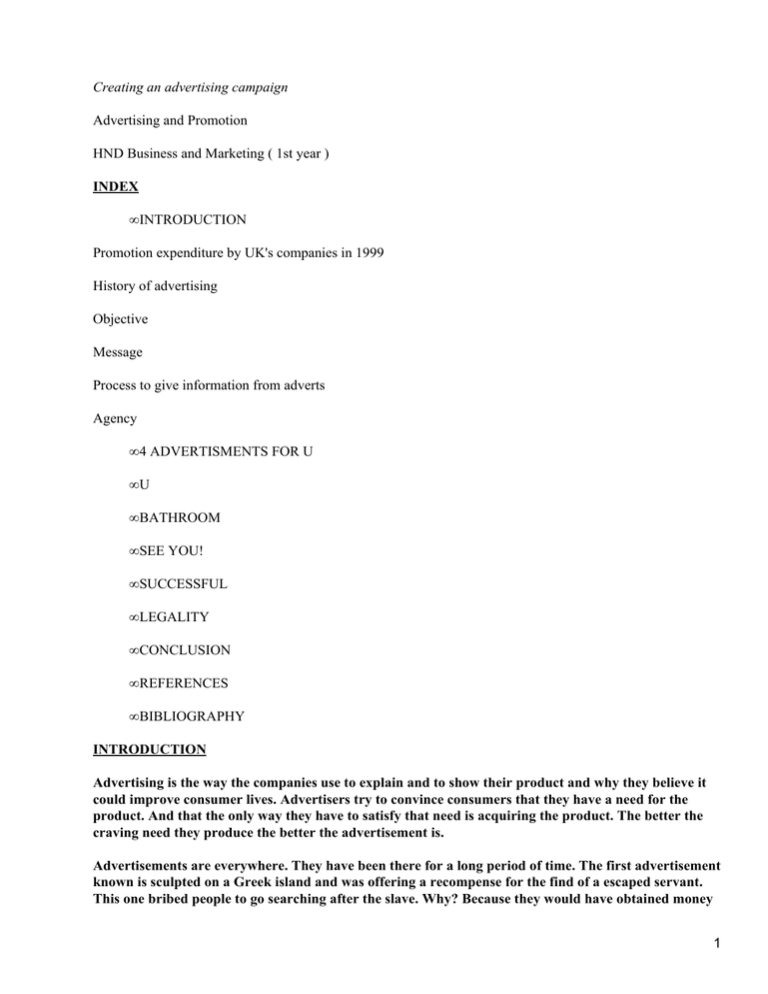
Creating an advertising campaign Advertising and Promotion HND Business and Marketing ( 1st year ) INDEX • INTRODUCTION Promotion expenditure by UK's companies in 1999 History of advertising Objective Message Process to give information from adverts Agency • 4 ADVERTISMENTS FOR U •U • BATHROOM • SEE YOU! • SUCCESSFUL • LEGALITY • CONCLUSION • REFERENCES • BIBLIOGRAPHY INTRODUCTION Advertising is the way the companies use to explain and to show their product and why they believe it could improve consumer lives. Advertisers try to convince consumers that they have a need for the product. And that the only way they have to satisfy that need is acquiring the product. The better the craving need they produce the better the advertisement is. Advertisements are everywhere. They have been there for a long period of time. The first advertisement known is sculpted on a Greek island and was offering a recompense for the find of a escaped servant. This one bribed people to go searching after the slave. Why? Because they would have obtained money 1 in exchange of him. Advertisers try to display an image of the product in the consumer's mind by describing it with artistic and linguistic elements. They use graphic design and slogans. A slogan is the phrase, or couple of them, created with the aim of making the product remembered. These items will depend on the target market the advertisement is destined to attract. The target audience of a product is the one the company believes it will likely buy it. They form their idea based on a specific Market Study. The most frequent channel to reach the targets markets is print media: magazines, newspapers and street−posters. The average American receives at least one newspaper or magazine on a daily basis. He can opt to buy it over the counter or to have it sent home. I chose to analyse a campaign published in the kind of women magazine one could subscribe to during the late seventies to the early eighties. Promotion expenditure by UK's companies in 1999. Advertising is non−personal information that the company sends to mass audience through such as TV, radio, billboards or print. Firstly, the advantages for the companies of adverting will inspect then the disadvantages. Advertising is a manner to differentiation of competence. There are many products very similar in the market. Companies inform to the audience about which characteristics has their product, which are different to others. By way of advertising companies can send this information easily to the audience. There are many places where advertisements can be shown to the audience. The companies use channels where are better for them to contact with the target customers. Each company can adopt the advertisements to present its requirement. Advertising offers to the audience a positive image of the company. Usually, advert relates one product or brand with a pleasure situation. The people create a sublimate and positive relation between the product and the delightful situation. For example, in most advertisements of car, the companies do not offer characteristic about quality, power, engineer or high speed of the car, however advert shows a person, in an along motorway, without traffic jam and with a nice atmosphere. Advertisements will do good relation between imagines and products. Others products, such as water, or banking service are very difficult to be different, thus through advertising the company can transmit the characteristic that induce the customer to buy this product. Therefore, advertisement helps the company; it gives the ideal characteristic that a customer is seeking. However, advertising has disadvantages as well. With extra cost, that advertising has, is very difficult that the small companies can pay it. To do an advertisement campaign, a company needs to pay the advertising agency for create commercial, but the most expensive cost is to buy the medium, through the information can be received by the audience. Hence too much information which bombard the audience every day. It is difficult for the audience to pay attention to all the advertisements. Advertising has to use the humor, strong image to 2 catch the target audience's attention. If this it does not engender people use to remote control when ads appear. Company cannot select exactly kind that of people who will see the advertisement. For example how effective is advertisement for cat food on the TV, if only 5%of audience owns a cat. In this case the company that does this type of promotion will waste a 95% of the budget of that campaign. Although the advertisements have many advantages to promote products to the audiences, have disadvantages that the companies should examine before sending plenty of money on this. History of advertising Although marketing is a new popular subject, archaeologists have discovered in the Mediterranean countries pictures that are first advertisements in the history. Romans, Phoenicians and Greeks painted walls to announce gladiator flights, politician asked for votes or even to sell cosmetics. However, advertisements had not been analysed until 1908, when the first book that analysed the psychology of advertising was published. Since then, many researches have been doing investigating, giving information about motivation, human behaviour, how to persuasive the audience even a favourable atmosphere to advert. Advertisement can be considered today as a science. Nevertheless, although with the spirit advertisement than two thousand years ago to transmit and persuade people by advertisements it has been changed completely: • 414 billion dollars are spent each year on advertisement in whole world. Multinational company such as Procter &Gamble, General Motors or Philip Morris spent in 1997 more that 2000 millions dollars in advertisement each one. There are multinational companies that spend more than 10 % of their sales in advertisements, such as Ford or General Motors. For this reason advertising is a business which moves each year more money. • New mediums are used for adverting. Although two thousand years ago the advertisements were principally limited to walls. At the present time, TV, print, radio or even Internet delivers the message to consumers. New ways to transmit are been using. Therefore although the usefulness of advertisements was known long time ago, it was in the last centenary when began a complete development of this form of promotion, until now, the advertisement is considered in the principal way that companies have to contact with the audience. Objective Companies hope to reach their goal through the advertising. The objective that companies have with the advertising is to obtain extra income, because through the advertisement campaign of one product this product will become more popular and company can gain more benefit. But although in the long term the objective in advertising is the same, there are three kinds of strategies that the adverts follow. Firstly, advertisement that gives information about new product or new characteristic based on another product. For example the cosmetic company informs to the audience that a new cream which is more effective against the wrinkles. As a result, many companies prefer using advertising to communicate their message. Secondly advertisement is use to promote a product has already been very popular. This kind of advertisement tries to recall the audience that old product is able in the market. For example, in the case of Coca−Cola most people know this drink, however the advertisements of this brand can be frequently seen and it is always attractive in summer or holiday, when people will consume especially more this product. The advertisement 3 reminds continually the audience that product is obtainable. Advertisements influence the audience seriously, especially those expensive products, such as cars or house. As the customers ponder the decision before buying the product. The company tries with the advertising to make easy to buy the product. The strategy of advertisement will be different for different products. Advertisements operate always in different ways to achieve the last objective for a company is selling more products. Message Message is a sentence or idea that summarises the content of one advertisement. The message must attract the audience, keep their attention and curiosity, giving a strong feeling about the product. The message is not only what is said, but also on how it is said. The process to learn the message is in the next illustration. Process to give information from adverts But the message has to have several characteristics: • Clear: easily to be understood target audience. • Short: easily to remember. • Summarise: it has to summarise an idea or principal attributes of one product. Therefore, a message is essential in one advertisement that gives much information to the audience, hence the message has to highlight and accent the features of the product. Agency Agency develops and executes advertising programs. Advertising field is each day more complicate. Even in companies with a strong marketing department, it is usual to contract special people to give the company all the services necessary in advertisement campaign in the same pack. Thus, the agency will develop all advertisement publicity working under the company. Agencies including full services in relation with the advertisement: researching, artwork, media buying or creative works are only the standard service that agencies offer nowadays. However, although most agencies offer similar services at the customer there are many different among agencies. The creative, culture and experience ability to transmit the message to target market are different qualities from agency to another. The right or wrong selection of an agency could be the success or failure of an advertising campaign. Therefore is not enough to have a large budget to guarantee the success in advertisement campaign, the know−how of the agency will be essential in the triumph. The agency usually has to find one characteristic or invented this to distinct one product from others products in the market. Consequently, agencies elaborate and choose the message diverse mediums and decide the structure of the advertisement. Other times the agency presents various campaign with several slogans and kinds of advertisement, in this case the company takes the responsibility to choose the camping. 4 ADVERTISMENTS FOR U Advertising Agency: Durrington Agency Client: U & U Ltd. 4 Product: U − Shower gel and shampoo Art Director: Rinchar Brief: After long time as sales leader in its sector market, U & U Ltd. has decided to start a new TV campaign for its new line of shower gel and shampoo named U. This campaign introduces the new product through (4) four different TV advertisements, using AIDA's formula. Date: 14/01/'04 Media: ITV (Channel 3) Budget £: Indefinite (x) Copy/Air Date: Evenings (from 7pm. to 11pm.), 7 days/week Target Audience: From class 2 to class 7. Between middle class and working class. Any Family Life Cycle (any age). Objectives: To attract the public's attention, doing easier the product's recognition in the market, and to accelerate the product's sales from the beginning. Proposition: To persuade the target audience. Support: Ad n.1 Do you know U? Ad n.2 Use U! Ad n.3 See you! Ad n.4 Because of U, shampoo! Tone: Informal. Desired Response: Spontaneous interest for the brand and its characteristics. Attitudes: To talk about the new product thanks to this campaign, and to start the products consume. Date issued: 14/01/'04 Due date: Daily Time allowance: From 7pm. to 11pm. (Prime time) Price: £ 30,500 (each 30 seconds) TV Channel: Channel 3 (ITV) 5 Description: Ad n.1 Different people say YOU, because everyone can use U, and because is an interesting way to attract everybody's attention. At the end, a bottle of U is showed in a beach, to give the answer to the public. This is in a beach because the waves and sun are attractive, and at the same time the wave's foam reminds you the foam when you are having a shower or having a bath. Ad n.2 A showman or a known person present to the public in a bathroom the typical gel and shampoo options, but informing about the new option: U. Ad n.3 See you! It is another way to remember quickly to every potential customer that U is in the market. Awareness guaranteed, in a funny version of double sense see−sea & you−U. Ad n.4 Successful is the advertisement to use when the brand is stabilized. LEGALITY Hair Advertisers should have scientific evidence to support any claims that their product will affect the physical health of hair as distinct from improving its appearance. The British Code of Advertising, Sales Promotion and Direct Marketing contains specific rules for health and beauty advertisements which cover general health claims, cosmetics, hair and scalp products, and vitamins and minerals. The specific rules are used in addition to the general principle of the CAP Code that advertisements should be legal, decent, honest and truthful. CONCLUSION There is much information published about advertisement. This assignment has tried to do an analysis of all the part that forms one advertising campaign. Advertising field is one way that companies have to promote their products. This area under discussion has changed suddenly in the last century. Nowadays is a complicate matter where the companies invest much money. However advertisement has been studied more deeply. The different component that it has and the steps to follow when it transmits information have been aspect important in this assignment. Many examples have been giving to explain the theory. But, may be the major conclusion that we could have when read this project, it is the use the advertising has for the companies. REFERENCES Office Of Communications (2004) (Internet) Available from: www.ofcom.org.uk / Accessed January 7th, 10th, 14th 2004. Advertising Standards Authority (2004) (Internet) Available from: www.asa.org.uk / Accessed January 7th, 10th, 14th 2004. BIBLIOGRAPHY 6 Needham, D., Dransfield, R., Guy, P., Shaw, M., Dooley, D. (1999) Marketing for Higher Awards, Oxford, Heinemann Educational Publishers Ltd., P 94 − 212. Solomon, M. R. (2002) Consumer Behaviour buying, having, and being, New Jersey, Prentice−Hall Inc., P 255 − 282. Cooper, A. (1997) How to plan advertising, London, Cassell, P 56, 153. Jones, J.P. (2002) The Ultimate Secrets of Advertising,California, Sage Publications Inc. Repetition of advertising: Ads is learnt Audiences understand the message 7
